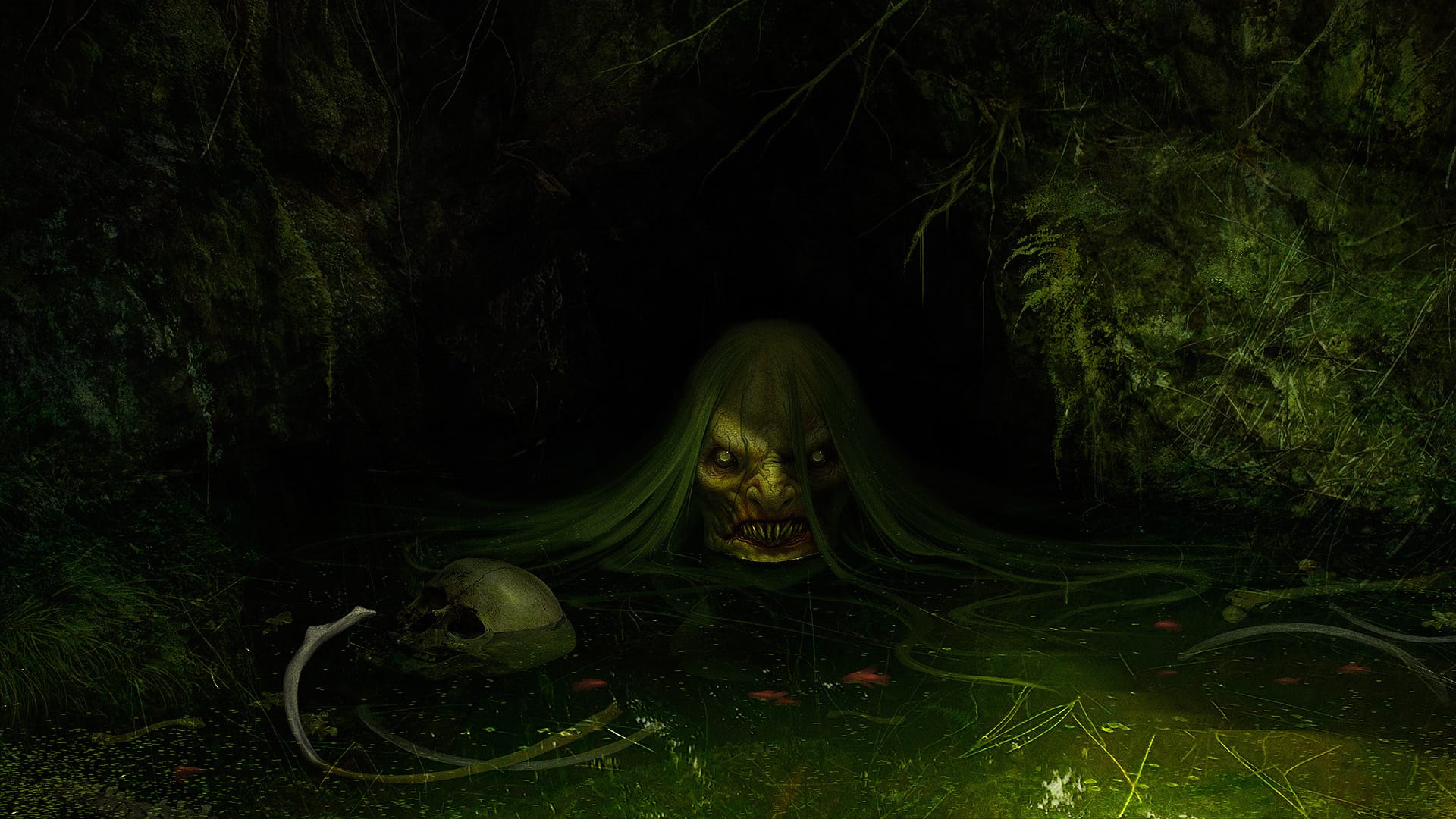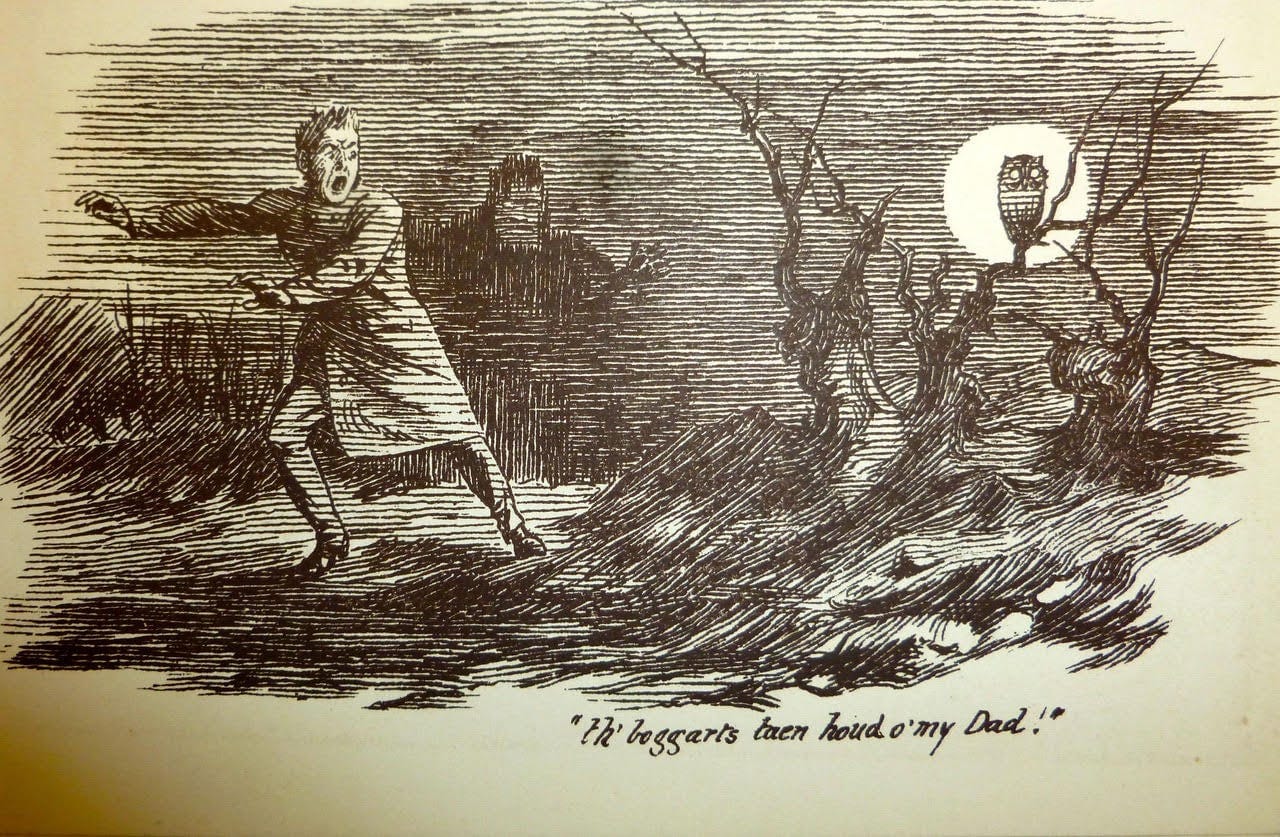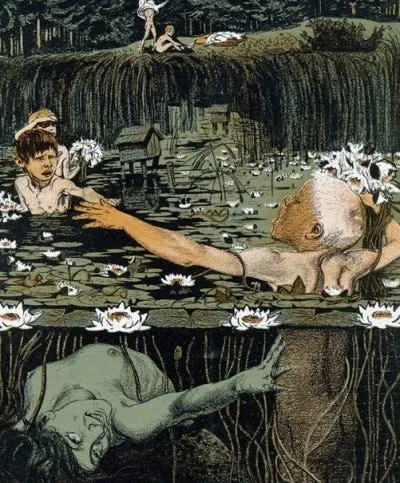By Dani Cole
Beware the water’s cloak of duckweed. Our city is crisscrossed by water — the canals that cut through the earth, the mill ponds, the ancient rivers. There is danger everywhere: even on a quiet day when the ponds are still, the rivers and brooks run clear and shallow, and you can see all the way down to the pebbled bed. Keep an eye out for the long, green tresses that sway in the currents. This is the domain of the frog-skinned water-witch Jinny Greenteeth.
She’s well-known in these parts — all across Lancashire and Manchester. She is sometimes known as Jenny or Ginny, too. To some, she’s a tale conjured up by fretful mothers and grandmothers to terrify children into good behaviour. My colleague Jack says his mum goes white as a sheet at the mention of Jinny. She grew up in Sale and when she was a young girl, she was warned not to venture too close to Bridgewater Canal, which was at the end of their road, "because Jinny Greenteeth would leap out of the canal and snatch her up."
The water-witch lurks in the shaded, quiet places where unwitting children and the frail may fall prey to her. Jinny has long, sinewy arms and clawed hands; her eyes are big, like two sightless globes. She likes the tender flesh of infants, which she feeds into her sharp-toothed maw. Depending on who you speak to, there are different ways she can get you. In 1891, the Burnley Express ran a story about the cotton famine, which contained the rhyme: “Hey lads! Hey, lads, run for yo’re life. Owd Jinny Greenteeth’s comin’ with a knife.” She can magick up a fever, or lure you into the water where she drowns you, or sometimes she slithers onto the land and climbs the branches of trees. If you are out at night and hear the wind whipping through the leaves, be sure to look up.

She’s been known to lurk in the River Irwell, close to the weir near Bury Bridge. In the olden days, a traveller walking up Far Lane in Gorton may have happened upon a lone figure sitting on the wall — it was prudent to hurry past and not linger too long. One favourite haunt was said to be at an old mill dam where the brook divides Moston from Newton Heath. One writer in the Manchester Guardian’s ‘Local Notes and Queries’ section in 1874 wrote of the childish thrill of tempting the river hag:
When in company of other boys, it was thought a daring deed to take a flying leap over the stream, and dare Jenny to seize us, a piece of boldness often dearly repaid by wakeful nights or troubled dreams.
In a 1930 story by T. Thomson in the Manchester Guardian, a woman tells her grandson’s friend, “Aw’ve just seen Jinny Greenteeth, an hoo’ll says hoo’ll bite t’hi yed off if tha says owt about them cheers and that table.” The threat comes after the poor boy, called Joe, says that the new chairs and the table that have appeared in the woman’s house “belung to his mammy.” He tearfully promises “to be dumb” and say nothing more. The woman duly puts on her bonnet and goes out to plead with Jinny not to eat him. 19th century Rochdale writer John Trafford Clegg ("Th' Owd Weighver") wrote an exchange about someone who hadn’t heard of Greenteeth in Stories, Sketches, and Rhymes in the Rochdale Dialect.
‘Yo’n ne’er sin Jinny Greenteeth then?’
‘Never,’ t’ chap laughed. ‘I have not even heard of the lady.’
‘W’ve getten into a very ignorant part o’ t’ counthry, it looks to me,’ aw said.
‘Onybody’at’s bin waythercress getherin or catchin loaches knows Jinny Greenteeth.’

One authority on Greenteeth was John Higson, who was born in Gorton in 1825 and came from an illiterate family. Higson wrote much on local folklore and was published in newspapers as well as The Gorton Historical Recorder. Last year, folklore historian Simon Young published South Manchester Supernatural: The Ghosts, Fairies, Boggarts, which compiled Higson’s writings. Young also published a pamphlet on ‘Jennydom’, which included a map of the lands across the North West where she crops up. She is usually present where curious and carefree children like to play: in 1870, Higson mentioned “Shooter’s Brook” which “passes in a culvert under the aqueduct which carries the Manchester and Ashton-under-Lyne Canal over Store Street, near the London Road Station.” It was a “dangerous spot” for children to play beside, and yet they “often selected it.”
Jinny was so well known a hundred years ago that she crops up in writing that isn’t even about her. In 1907, on a “cheerless day at the end of October”, journalist James Haslam went in search of Joe Bates, “Owd Thatcher”, an old handloom weaver and the “last of his race”. “It was very seldom that a handloom weaver was called by his full or proper name,” Haslam wrote. “Among the women Jinny Greenteeth, Donkey Sally, Jumping Mary, Tally Bet &c.” Owd Thatcher remarked: “Some or eawr names ‘ud mak’ rum readin in these new-fangled times.”

The shadow of Jinny reaches as far into the living memory of Mancunians too: biographer Carol Ann Lee writes that Myra Hindley once crept into Gorton Tank, and used to swim in the disused reservoir in Mellands Fields on the outskirts of Gorton. There was a common warning given to the children: “Don’t go in, mind, cos the Jenny Green-teeth will drag you under.” In 1957, Hindley’s 13-year-old friend Michael Higgins drowned. A requiem Mass was said for him at St Francis’s Monastery. Lee writes: “Myra dreamed of Michael that night, of trying to swim under the dark, reedy water to save him.”

Comments
How to comment:
If you are already a member,
click here to sign in
and leave a comment.
If you aren't a member,
sign up here
to be able to leave a comment.
To add your photo, click here to create a profile on Gravatar.






